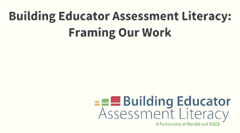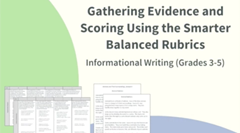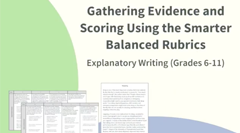The following professional development tools provide suggestions for leveraging the Understanding Proficiency resources to support educators’ learning. Each tool has suggested activities for a 1.5-hour session and for a 3-hour session.
English Language Arts/Literacy Professional Learning Tools
- Unpacking a Performance Task
Examine an ELA/Literacy performance task to understand the cognitive demands on students and the implications for instruction.
- Scoring Session with Understanding Proficiency Resources
Use the Understanding Proficiency unscored student work samples and scoring keys to understand Smarter Balanced scoring criteria for full writes, and what student writing looks like at each of the score levels in each of the writing dimensions.
- Examining Grade-Level ELA Standards with Understanding Proficiency Tools
Use Understanding Proficiency student samples to examine the progression of standards across grade levels.
- Conducting a Scoring Session Using Your Own Students’ Work
Teachers examine their own students’ work against one or more dimensions on the rubric.
- Exploring Proficiency for English Learners
Analyze a case study of an English Learner (EL), exploring strengths and strategies to support ELs in demonstrating college and career readiness.
Video Resources
 Building Educator Assessment Literacy – Assessment Continuum
Building Educator Assessment Literacy – Assessment Continuum
This video provides an overview of Smarter Balanced performance tasks, their part in the Smarter Balanced assessment system, and how they fit into the assessment continuum.
 Gathering Evidence and Scoring – Elementary
Gathering Evidence and Scoring – Elementary
This video demonstrates a process for using evidence-based scoring to evaluate student writing using the Smarter Balanced Informational Rubric (Grades 3–5).
 Gathering Evidence and Scoring – Secondary
Gathering Evidence and Scoring – Secondary
This video demonstrates a process for using evidence-based scoring to evaluate student writing using the Smarter Balanced Explanatory Rubric (Grades 6–11)